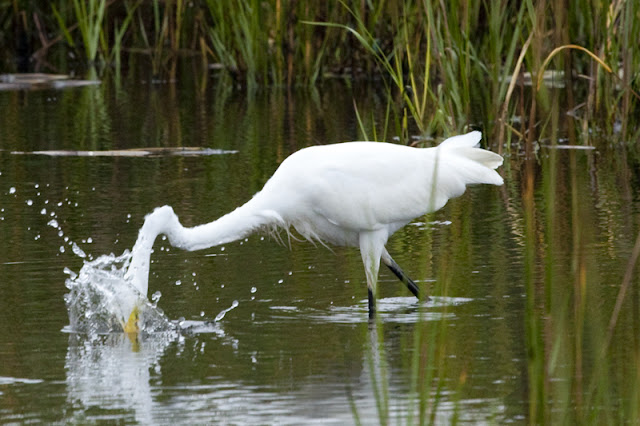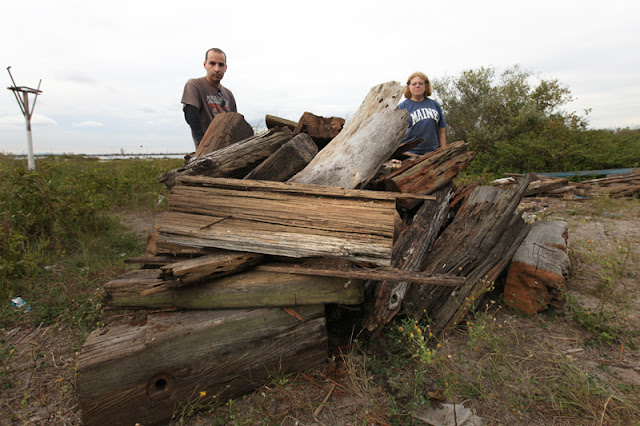And the resulting logjam-boree.
The deluge was intense. To illustrate, here's the main pool today vs. during a dry spell.
Throughout the day I kept crossing paths with Jim Henson's lost creation.
Here less muppet-like. A great egret's dagger bill is lethal when it comes to sniping unsuspecting fish and non-fish.
It stalks silently through the marsh, searching for any movement in the water. When a potential meal is detected, the egret zeroes in, cocks it's neck and like lightning...
This individual was a pro. Not a single fumble in the dozen strikes I witnessed.
It was an especially birdy day all around thanks to the fall migration. Geese, cormorants, four raptor species and an endless procession of tree swallows coasted over Rocky Point. It took one flock of swallows two hours to pass overhead. During our last volunteer day, USFW biologist Steve Finn told me about the non-avian migrants he observed in the marsh:
The butterflies are the most interesting to me at this time of year with their different survival strategies. Some migrate south in advance of the cold weather. Most notable are our monarch butterflies that migrate to the Oyamel forests in Mexico, where they will spend the winter. Lesser migrations to our southern states are performed by some of our other butterflies such as the question mark, ladies and morning cloak, although some of the morning cloaks don't migrate and stay to hibernate in a sheltered place such as a hollow tree.
During our marsh clean up on Saturday we disturbed such a sleeper when Tony and I unloaded a pile of wood taken from the marsh waste (left). Finally (and perhaps sadly) we witnessed butterflies in the marsh area such as the beautiful common buckeye (right) that immigrated northward during the summer to explore new habitat, food sources and reproduce. These will stay with us into autumn until they are finally killed by the frost. The only good news is that they will be replaced next year with fresh southern immigrants.
Following the marsh work I went fishing with Tony down the beach from the marsh. Here again we witnessed migration. The bait fish (peanut bunker or young of the year menhaden) were heading towards the inlet to migrate south from their nursery grounds in the bay. They were being heavily fed upon by migrating snapper bluefish, striped bass and false albacore trying to fatten up before their long trip south.
In hopes that a few migrating birds will stopover in the marsh, I decided to deploy camera trap #2 on the osprey platform. But the cradle, whose not-very-hurricane-proof design resulted in the demise of camera trap #1, required modification.
It's not overly sophisticated, but this little brace will help secure the camera during a big gust.
The glorious view from the roof of the marsh. What weary traveller wouldn't want to take a rest here?
I finished off the day in Matchstick Alley. It's slow going, but the channel is beginning to open.
High of 75, max humidity 90%, average wind (ESE) @ 11 MPH, 7.0 high tide @ 08:49 AM. Moon 0% visible.
Water level recorded at 30" mark (marsh record high). Yardstick broke shortly thereafter.
Birds seen in marsh: belted kingfisher, green heron, great egret, osprey, merlin, peregrine, unidentified accipiter, black duck, Canadian goose, flicker, warbler, tree swallows, grackle, many large gulls.

























































